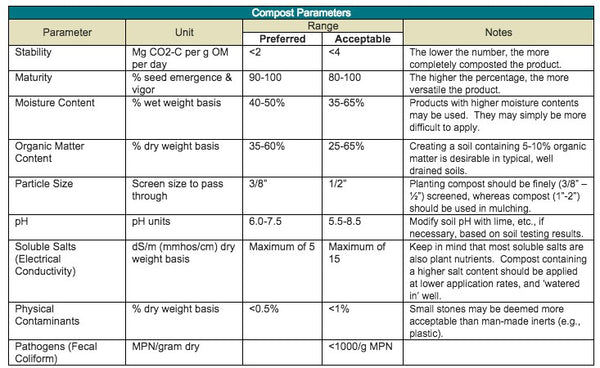How Does Your Compost Stack Up?
A&L Great Lakes Laboratories, Inc. receives many calls relating to compost quality. Frequently the question is somehow related to: “How can I tell if my compost report numbers are good or not?” The answer can vary depending on what the client is using the compost for and if there is an EPA, state, county, or municipal requirement that must be met. Sometimes the compost is mixed in with soil or other material to make a blend which is governed by private engineering or governmental regulations, such as DOT (Department of Transportation) specifications. All of this can lead to confusion, especially to the end consumer. The US Composting Council has provided some very useful guides outlining the “preferred” and “acceptable” ranges of compost for different consumer uses. Below is an example guide for use in a Flower and Vegetable Garden:

While these guidelines provide excellent direction for evaluating compost quality, government and engineering specifications do not always align exactly with the US Composting Council’s ranges. The laboratory has analyzed composts that are perfectly good and viable (as a growing medium), and within all the USCC’s recommended ranges, but failed to meet a specific engineering specification. This can be very frustrating for the compost producer. In one particular instance, the lab tested compost that met all the human safety requirements (Bacteria and EPA 503 Heavy Metals), plants grew well in it, and it was mature. In addition, the nutrient content, pH and soluble salt levels were spot on. However, it still failed to meet a specification because the organic matter was 20%, which was considered too low. In this example, the engineer was creating a blend that required a minimum organic matter content and, if using the planned blending recipe, the final blend would not have met their specifications. Rather than invalidate this compost, an alternative was to change the blending recipe by increasing the amount of the compost used to achieve a blend that would have met the specs. Another alternative would have been to evaluate the specifications of the final blend to determine if the specified minimum organic matter content was actually necessary to meet the needs for this situation.
A number of different compost parameters can be analyzed, but some parameters are more important in different situations than others. For example, nutrients, fecal coliform and heavy metals may be important for composts that contain animal manures or biosolids and that might be land applied, while sieve size, odor presence, organic matter content and weed seed viability may be important to landscapers. Also, where quantifying the concentration of man-made materials such as glass, plastic, and metal, may be appropriate for yard trimmings compost, it may not be appropriate for biosolids or food by-product compost.
A PDF document entitled “Compost Characteristics and Their Importance,” as well as a basic A&L Great Lakes Laboratories Compost “FACT SHEET” are available to help you understand compost data better. If you are interested in receiving either of these publications, or would like to discuss your particular compost or composting project, please contact Greg Neyman gregn@algreatlakes.com.



